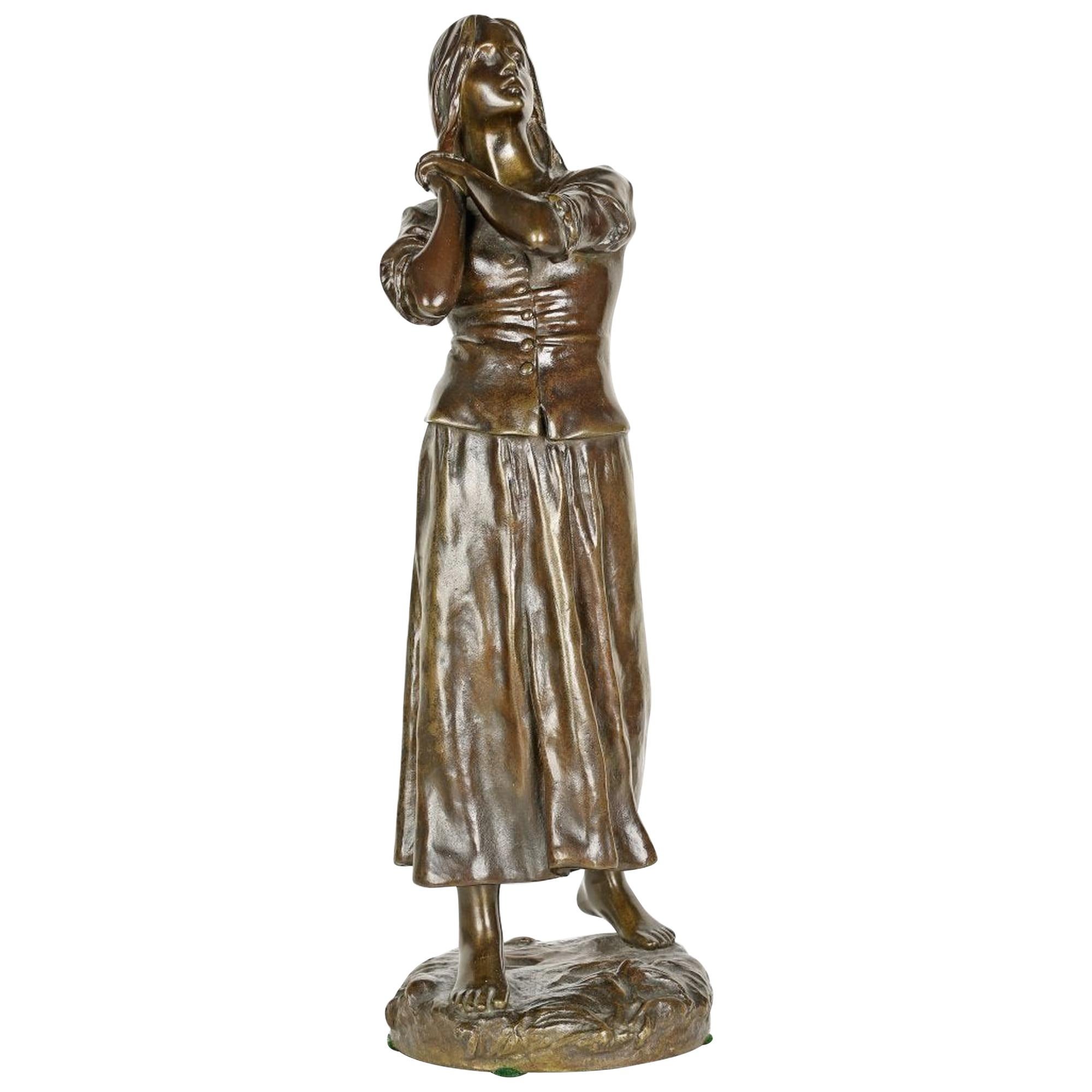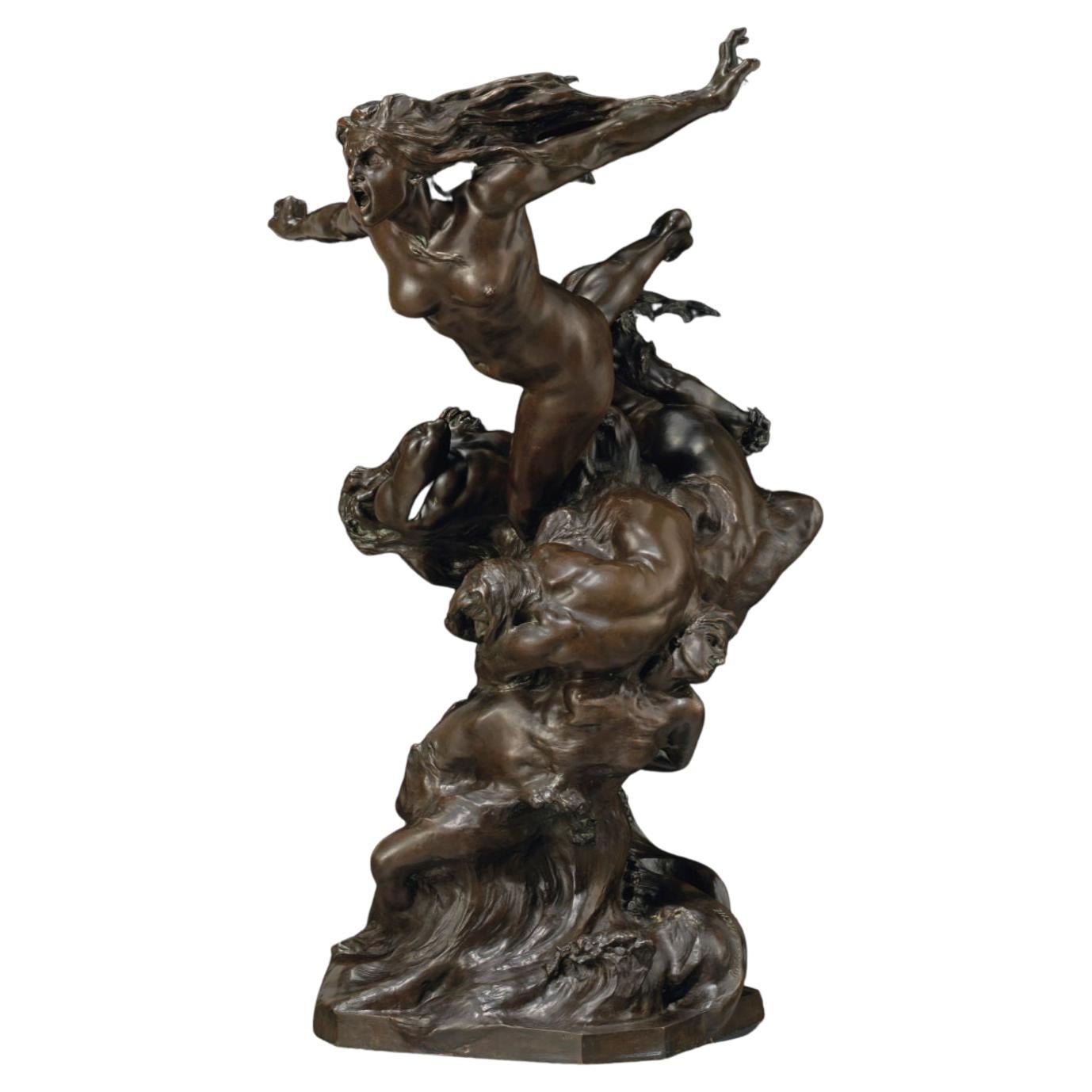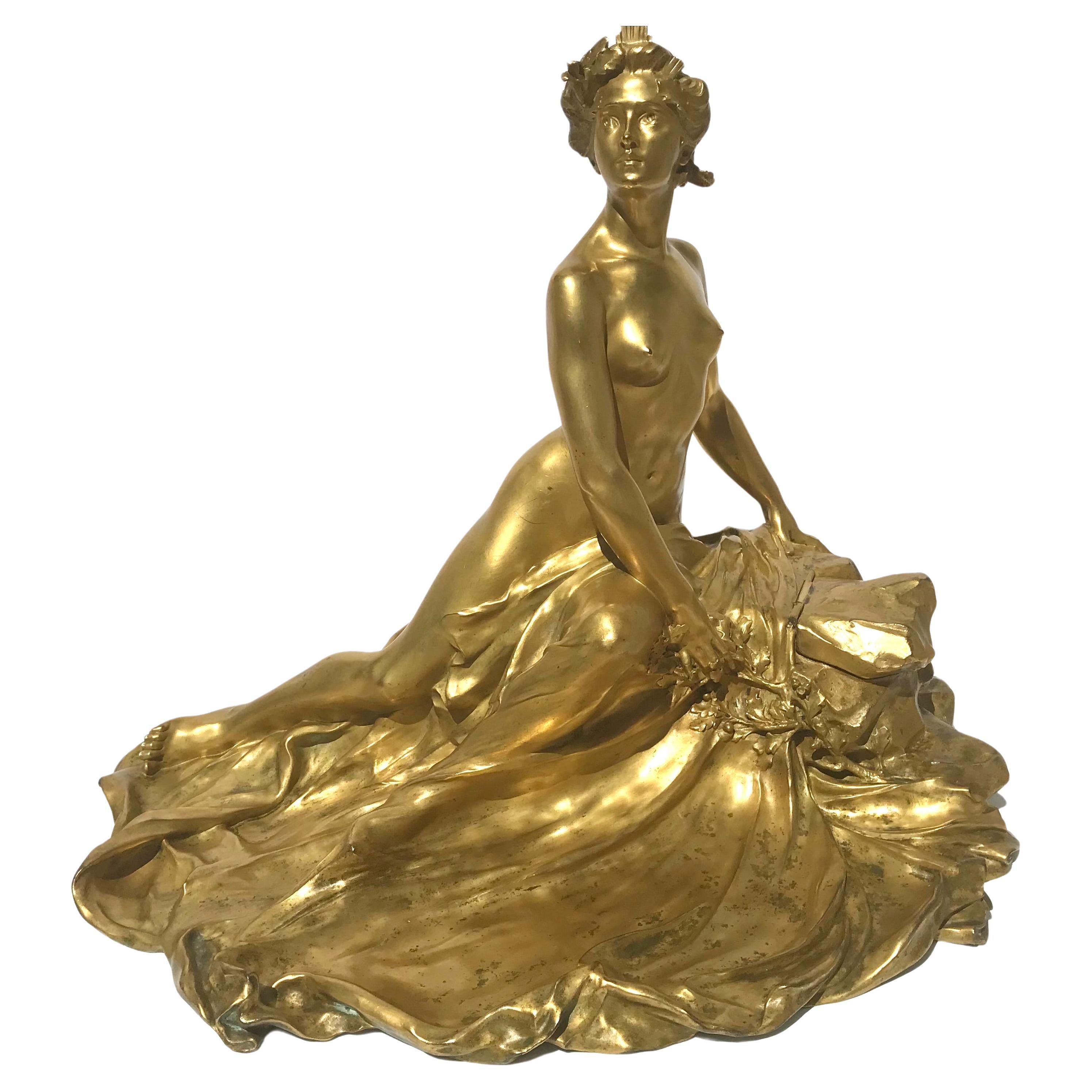Items Similar to 'Cupid & Psyche' an Important Bronze Figure by François-Raoul Larche
Want more images or videos?
Request additional images or videos from the seller
1 of 5
'Cupid & Psyche' an Important Bronze Figure by François-Raoul Larche
About the Item
'Cupid & Psyche' - An important parcel-gilt and patinated bronze figure, by François-Raoul Larche.
Signed to the base 'Raoul Larche 1891'.
This finely cast parcel-gilt bronze figure depicts Cupid and Psyche with Zephyr.
François-Raoul Larche (1860-1912), the son of an ornamental sculptor, was a well-known Art Nouveau sculptor born in St.-André-de-Cubzac. He entered the Ecole des Beaux-Arts in Paris in 1878, studying under François Jouffroy, Eugène Delaplanche and Alexandre Falguière.
French, Dated 1891.
- Creator:François-Raoul Larche (Maker)
- Dimensions:Height: 27.96 in (71 cm)Width: 18.51 in (47 cm)Depth: 13 in (33 cm)
- Materials and Techniques:
- Place of Origin:
- Period:
- Date of Manufacture:1891
- Condition:Wear consistent with age and use.
- Seller Location:Brighton, GB
- Reference Number:
About the Seller
5.0
Recognized Seller
These prestigious sellers are industry leaders and represent the highest echelon for item quality and design.
Established in 1964
1stDibs seller since 2014
49 sales on 1stDibs
Typical response time: 1 hour
Associations
The British Antique Dealers' AssociationLAPADA - The Association of Arts & Antiques Dealers
- ShippingRetrieving quote...Ships From: Brighton, United Kingdom
- Return PolicyA return for this item may be initiated within 7 days of delivery.
More From This SellerView All
- Three 'Art Nouveau' Sculptural Centrepieces by François-Raoul LarcheBy François-Raoul LarcheLocated in Brighton, West SussexFrançois-Raoul Larche (French, 1860 - 1912). Three 'Art Nouveau' Gilt-Bronze Sculptural Centrepieces. Comprising a large pair of centrepieces and a ...Category
Antique 19th Century French Art Nouveau Decorative Bowls
MaterialsBronze
- An Art Nouveau Bronze Figural Ewer by Auguste LedruBy Auguste LedruLocated in Brighton, West SussexAn Art Nouveau Bronze Figural Ewer Modelled With A Water Nymph by Auguste Ledru, Cast by Susse Frères. Inscribed 'Susse F. Paris Edt.', stam...Category
Antique 19th Century French Art Nouveau Mounted Objects
MaterialsBronze
- 'The Juggler', an Art Deco Bronze Figure, by Claire J. R. Colinet, circa 1925By Claire Jeanne Roberte ColinetLocated in Brighton, West Sussex'The Juggler' - A fine Art Deco silvered bronze figure, by Claire J. R. Colinet. French, circa 1925. Engraved to base 'CL J.R. Colinet'. This dramatic and large silvered b...Category
Early 20th Century French Art Deco Figurative Sculptures
MaterialsBronze
- Large Multi-Patinated Bronze Figure of an Arab Warrior by Henri-Honoré PléBy Henri Honoré PléLocated in Brighton, West SussexA Large and Important Multi-Patinated Bronze Figure of an Arab Warrior by Henri Honoré Plé. Signed Henri Plé to the base. The figure is finely modelled as an Arab warrior, with sw...Category
Antique 19th Century French Figurative Sculptures
MaterialsBronze
- An Orientalist Lifesize Figural Bronze Statue, Attributed to Louis HottotBy Louis HottotLocated in Brighton, West SussexAn Orientalist Lifesize Figural Bronze Statue, Attributed to Louis Hottot (French, 1834-1906). Modelled as a lady in Ottoman dress standing beneath an Eastern style pagoda with mina...Category
Antique 19th Century French Figurative Sculptures
MaterialsBronze
- ‘Gloria Victis’, A Patinated Bronze Figural Group by Mercié, Cast by BarbedienneBy Ferdinand BarbedienneLocated in Brighton, West SussexA Patinated Bronze Figural Group of ‘Gloria Victis’ (‘Glory to the Vanquished’), Cast by Ferdinand Barbedienne from the Model by Marius-Jean-Antonin Mercié (French, 1845-1916). ‘Gloria Victis’ (‘Glory to the Vanquished’). Bronze, gilt and dark brown patina. Signed 'A. Mercié', with foundry inscription 'F. BARBEDIENNE, Fondeur. Paris.' and A. Collas reduction cachet. The integral base titled 'GLORIA VICTIS'. This cast is part of a limited edition by the Barbedienne Foundry. France. Circa 1880. ‘Gloria Victis’ is one of the most recognisable and important works of sculpture of the nineteenth century and a definitive image of France’s historic national identity. The figure of glory, winged and wearing armour, carries a dying young warrior heavenwards towards fame and immortality. The compositional daring of the group must be admired for balancing two figures on the minimal support of one foot, wings spread in the moment before taking flight. Mercié was a student at the French Academy of Rome when the Prussians invaded France in 1870. Shortly after the war had begun, he executed a group depicting the figure of Fame supporting a victorious soldier. When news reached Mercié in Rome that the French had surrendered, he decided to alter his group, replacing the victorious soldier with a defeated casualty, thus transforming an allegory of ‘Glory to the Victors’ into one of ‘Glory to the Vanquished’. Completed in 1872, a year after the defeat of French soldiers against the Prussian army, the statue personifies a defeated but heroic France. The title is also a reversal of the famous formula, ‘Vae Victis’ (Death to the Vanquished), which the Gallic general Brennus exclaimed upon defeating the Romans in 390 BC. The figure of the fallen soldier was thought to represent Henri Regnault, a fellow sculptor of Mercié who was killed on the last day of fighting. Measuring 317 cm. high the original group of ‘Gloria Victis’ was unveiled in plaster at the Salon of 1872. It was bought by the City of Paris for the sum of twelve thousand francs and then cast in bronze by Victor Thiébaut for eight thousand five hundred francs. The bronze was exhibited at the Salon in 1875 and first placed in Montholon Square in the 8th arrondissement. In 1884 it was transferred to the courtyard of the Hôtel de Ville and in 1930, it entered the collection of the Musée du Petit Palais, where it can be seen to this day. The Thiébaut Frères foundry also cast Gloria Victis bronzes for the cities of Niort (requested 1881) Bordeaux (requested 1883), Châlons-sur-Marne (today, Châlons-en-Champagne; requested 1890), and Cholet (requested 1901). In 1905, the Danish brewer and art collector Carl Jacobsen was permitted to have an exact cast made of the original sculpture in Paris, on condition that the base was made 2 cm lower and bore the inscription “Original tilhører Paris By” (The original belongs to the City of Paris). It too was cast by the Thiébaut Frères foundry. Gloria Victis was one of Jacobsen’s most important and his last acquisition. Today it has been returned to its original position in the Winter Garden at Glyptoteket, Copenhagen, Denmark. The full-size plaster was shown again at the Paris Expositon universelle of 1878 alongside a bronze reduction by Barbedienne. By this time Antonin Mercié had entered into a commercial edition contract with the Ferdinand Babedienne foundry to produce bronze reductions of Gloria Victis, his most famous work. Gloria Victis is first recorded to have been produced in three sizes and by 1886 Barbedienne’s ‘Catalogue des Bronzes D’Art’ lists six sizes measuring 3/5, 9/20, 7/20, 3/10, 6/25 and 2/10, of the original. These reductions were produced by an invention of Barbedienne’s business partner Achille Collas. The Collas reducing machine was a type of complex mechanical pantograph lathe that enabled sculpture to be mathematically measured and transcribed to scale, in the round, thus making a reduced size plaster from which a bronze could be cast. Mercié's modern sculpture had become an instant classic, even receiving an entry in the Nouveau Larousse Illustré. The success of the group undoubtedly lay in the fact that it was admired not just on an aesthetic level, but also on a patriotic level, particularly in its commemoration of heroism in defeat. Immediately ‘Gloria Victis’ was recognised as a national artwork, capable of arousing patriotism and casts were ordered from Barbedienne as local memorials commemorating the war’s dead for cities across France. ‘Gloria Victis’ was considered so much a part of France’s national identity that for the 1900 Paris Exhibition, Ferdinand Barbedienne’s nephew Gustave Leblanc, loaned a bronze example to feature as part of l’Exposition centennale de l’art français. Literature: For an interesting account of the process of creating a reduction in bronze of the Gloria Victis by Barbedienne and illustrations of the casting and finishing of the bronze see: 'Ferdinand Barbedienne': Theodore Child; Harper's new monthly magazine, Volume 73, Issue 436, September 1886. ‘Contemporary French Sculptors’: The Century, Volume 33, Issue 3, Jan 1887. ‘Modern French Sculpture’: Harper's new monthly magazine, Volume 76, Issue 452, January 1888. S, Lami, ‘Dictionnaire des sculpteurs de l'Ecole française au dix-neuvième siècle’, Tome III. G.-M., Paris, 1914, p. 432. Peter Fusco and H.W. Janson, The Romantics to Rodin: French Nineteenth Century Sculpture from North...Category
Antique 19th Century French Figurative Sculptures
MaterialsBronze
You May Also Like
- Raoul Fançois Larche Patinated Bronze Figure of a womanBy François-Raoul LarcheLocated in West Palm Beach, FLRaoul François Larche (1860-1912) A lovely patinated bronze figure of a young woman standing barefooted on a circular mounted base and gazing up...Category
20th Century Figurative Sculptures
MaterialsBronze
- Francois-Raoul Larche Bronze Sculpture La Tempête et les NuéesLocated in New York, USOur important bronze by Francois-Raoul Larche (1860-1912), cast circa 1905, is entitled La Tempête et les Nuées (The Storm and the Clouds). Signed RAOUL. LARCHE and stamped with the ...Category
Early 20th Century French Neoclassical Revival Figurative Sculptures
MaterialsBronze
- Important Patinated Bronze Group Depicting Cupid and PsycheBy Henri GodetLocated in New York, NYTitle: The Abduction of Psyche Maker: Henri Godet (French, 1863-1937) Date: circa 1896 Dimension: 40 in. x 16 in. x 10 in. Notes: The love story of cupid and the beautiful pri...Category
Antique 19th Century French Figurative Sculptures
MaterialsBronze
- 23” Raoul Larche 'L'Idée, Allégorie sur un Rocher' Gilt Bronze InkwellBy François-Raoul LarcheLocated in Dallas, TXRaoul Larche (1860-1912) Monumental Inwell vide pouch. 'L'Idée, Allégorie sur un Rocher' A Gilt-Bronze Inkwell, circa 1900 Figural Centerpiece, Inkwell and vide pouch. Gilt-bronze H...Category
Vintage 1910s French Art Nouveau Figurative Sculptures
MaterialsBronze
- Raoul Larche, Gilded Ormolu Group of Two Children PlayingBy François-Raoul LarcheLocated in Brighton, SussexA good quality late 19th century French gilded ormolu group, depicting two bathing children playing with a fishing basket. François-Raoul Larche (1860 Saint-André-de-Cubzac - 1912 Paris) was a French Art Nouveau sculptor whose work included several figures of Christ...Category
Antique Late 19th Century French Art Nouveau Figurative Sculptures
MaterialsOrmolu
- Early 20th Century French Art Nouveau Sculpture "La Mer" by, Raoul LarcheBy François-Raoul LarcheLocated in Englewood, NJAn important & monumental early 20th century French Art Nouveau gilt and cast bronze "Surtot De Table" (Centerpiece for a table) titled "La Mer' by, Francios Raoul Larche depicting mermaids emerging from within the sea amongst seaweed and water holding aloft three oyster shells with one figure emerging towards the top . The sculpture is signed with signature and foundry marks and is further a period sand casting finished in a gilt patina. circa 1900 Signature: The Sculpture is signed & impressed "Raoul Larche", further impressed foundry mark 'Siot Decauville Paris Fondeur" and numbered Measurements: Centerpiece: height: 29.5 in. x width: 32 in. x depth: 13 in.. Literature Philippe Dahhan, Étains 1900, 200 Sculpteurs de la Belle Époque, Paris, 2000, p. 229 Biography: The son of an ornamental sculptor, François-Raoul Larche was a well-known Art Nouveau sculptor...Category
Early 20th Century French Art Nouveau Figurative Sculptures
MaterialsBronze
Recently Viewed
View AllMore Ways To Browse
Gold Cupid
Bronze Cupid
Bronze Sculpture Andre
Cupid Sculpture
Cupid Figure
Cast Cupid
Ornamental Sculptures
Cupid And Psyche
Cupid Psyche
Bronze Sculpture Cupid
Andre Francois
Alexandre Falguiere
Psyche Bronze 19th Century French
Bronze Cupid And Psyche
Raoul Larche
Raoul Francois Larche
Larche Bronze
Raoul Larche Sculpture





